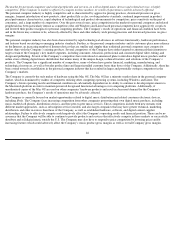Apple 2005 Annual Report Download - page 56
Download and view the complete annual report
Please find page 56 of the 2005 Apple annual report below. You can navigate through the pages in the report by either clicking on the pages listed below, or by using the keyword search tool below to find specific information within the annual report.
The Company expects its quarterly revenue and operating results to fluctuate for a variety of reasons.
The Company’s profit margins vary among its products and its distribution channels. The Company’s direct sales, primarily through its retail
and online stores, generally have higher associated profitability than its indirect sales. Additionally, the Company’s direct channels have
traditionally had more sales of software and higher priced hardware products, which generally have higher gross margins, than its indirect
channels. As a result, the Company’
s gross margin and operating margin percentages as well as overall profitability may be adversely impacted
as a result of a shift in product, geographic, or channel mix, or new product announcements, including the transition to Intel-based Macintosh
computers. In addition, the Company generally sells more products during the third month of each quarter than it does during either of the first
two months, a pattern typical in the personal computer industry. This sales pattern can produce pressure on the Company’s internal
infrastructure during the third month of a quarter and may adversely impact the Company’s ability to predict its financial results accurately.
Developments late in a quarter, such as lower-than-anticipated demand for the Company’s products, an internal systems failure, or failure of
one of the Company’s key logistics, components suppliers, or manufacturing partners, can have significant adverse impacts on the Company
and its results of operations and financial condition.
The Company has higher research and development and selling, general and administrative costs, as a percentage of revenue, than many of its
competitors.
The Company’s ability to compete successfully and maintain attractive gross margins and revenue growth is heavily dependent upon its ability
to ensure a continuing and timely flow of innovative and competitive products and technologies to the marketplace. As a result, the Company
incurs higher research and development costs as a percentage of revenue than its competitors who sell personal computers based on other
operating systems. Many of these competitors seek to compete aggressively on price and maintain very low cost structures. Further, as a result
of the expansion of the Company’s Retail segment and costs associated with marketing the Company’s brand including its unique operating
system, the Company incurs higher selling costs as a percentage of revenue than many of its competitors. If the Company is unable to continue
to develop and sell innovative new products with attractive gross margins, its results of operations may be materially adversely affected by its
operating cost structure.
The Company is exposed to credit risk on its accounts receivable and prepayments related to long-term supply agreements. This risk is
heightened during periods when economic conditions worsen.
The Company distributes its products through third-party computer resellers and retailers and directly to certain educational institutions and
commercial customers. A substantial majority of the Company’s outstanding trade receivables are not covered by collateral or credit insurance.
The Company also has unsecured non-trade receivables from certain of its manufacturing vendors resulting from the sale by the Company of
raw material components to these manufacturing vendors who manufacture sub-assemblies or assemble final products for the Company. In
addition, the Company has entered into long-term supply agreements to secure supply of NAND flash-memory and intends to prepay a total of
$1.25 billion under these agreements. While the Company has procedures in place to monitor and limit exposure to credit risk on its trade and
non-trade receivables as well as long-term prepayments, there can be no assurance that such procedures will be effective in limiting its credit
risk and avoiding losses. Additionally, if the global economy and regional economies fail to improve or continue to deteriorate, it becomes
more likely that the Company will incur a material loss or losses as a result of the weakening financial condition of one or more of its
customers or manufacturing vendors.
The Company’s success depends largely on its ability to attract and retain key personnel.
Much of the future success of the Company depends on the continued service and availability of skilled personnel, including its Chief
Executive Officer, members of its executive team, and those in technical, marketing and staff positions. Experienced personnel in the
information technology industry are in high demand and competition for their talents is intense, especially in the Silicon Valley, where the
majority of
54
























